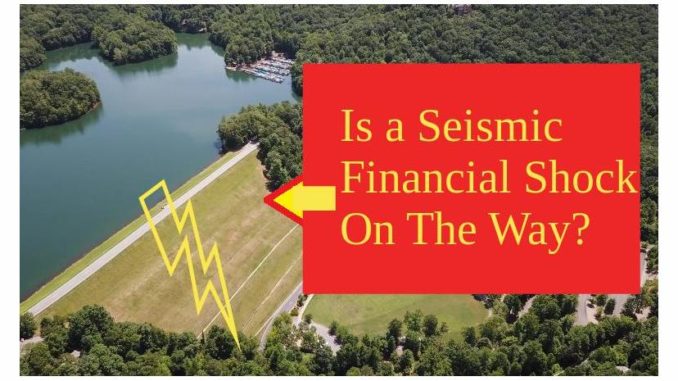
SHORT VERSION SUMMARY OF THIS ARTICLE:
The Board recently revealed that repairs to the Dam will run $4.5 Million. FOBC Sources now say this may be closer to $7 Million, and that even more engineering studies (and subsequent work) not previously estimated may be required. A new letter from GA Safe Dams finally puts in writing that the Geosyntec Seismic Study from 1998 was NEVER ACCEPTED by the State, and that as part of the new Permit Requirement for current work, GSD will first require a redo of the Seismic Study under the current worsening conditions of seepage, raised phreatic levels, etc… Documentation is provided showing two (2) reputable engineering firms previously coming to the same preliminary evaluation that Lake Petit Dam does NOT meet minimum Seismic Stability, with one Engineering firm’s concerns actually increasing, after reviewing information provided by the original Dam Design Engineer. In the event the newly required study also finds the Dam to be below mandatory seismic stability minimums, then the Dam could face a rebuild that extends its size, stretching deep into the lower ballfield; requires the reworking of the road below the Dam, and the moving of utilities. The complete draining of the Lake for a very substantial time period is likely. This scenario would possibly (“likely”) involve the complete digging out of the core of the Dam to get into and replace the Lower Level Outlet and Drain System. Based on similar situations at other Dams, and adjusting for the current inflationary climate (including labor and supply shortages), this could easily involve the doubling or tripling of the existing estimates. This is the short version. Below is the long version, with documentation.
PS…. Patricia Cross (BC Matters) just released an article suggesting Big Canoe is out of Cash Flow, and that New Loans are urgently being explored by a newly formed Finance Sub-Committee. It is really interesting timing considering that this Lake Petit Dam thing seems to suddenly be spiraling out of the POA’s control. Her newest article is definitely worth a read: https://bcmatters.org/always-needing-more/
***begin full article below ***
This Newspaper began reporting on the Lake Petit Dam Series of articles on August 12, 2020. So far a total of 14 articles have been written, including this one. From the very beginning, GM Scott Auer, and Board of Directors in general have denied that there was any problem with the Dam. They have ridiculed this Newspaper’s reporting. The “Official Story” was that none of this was real, everything was under control, and even if there were repair costs they would be small and easily manageable. As this has evolved, residents can now see that this is not true, and FOBC’s reporting has indeed been accurate.
In this article FOBC will drop new bombshell information, perhaps the most damaging, and potentially expensive yet, but first a quick review of where this project currently stands financially. In the November 18, 2021 Board Meeting, Regis Falinski says at Timestamp 2hrs; 16 mins; 55 secs:
“One thing that certainly goes without saying, but i’m known for saying things that don’t need to be said, we’re spending, the most important thing we’re doing, is spending over the next two years some four and a half million dollars to make improvements and enhancements to that dam“
FOBC Sources now indicate that this number could now be upwards of almost $7 Million Dollars. While this article isn’t even primarily about that, it is recommended that Property Owners start putting some pressure on GM Scott Auer and the BCPOA Board members to provide some straight answers regarding the range of costs they have received. The community is being lied to via omission of critical details.
Now to the gist of this article, which is about newly revealed confirmations regarding the Seismic Stability of Lake Petit Dam, and which could potentially double or triple the existing estimates. Through a series of communications and Open Records Requests, the Program Manager for Regulatory Support at Georgia Safe Dams (“GSD”) has just put into writing the fact that the earlier Seismic Stability Studies done by Geosyntec 2 decades ago….. “was not accepted“ by the state. It goes on to say that the POA is now being required to redo the Stablity Study. There is a lot more in that email (and there are more emails) but most of the subject matter relates to another serious issue… that being that Ga Safe Dams has NOT accepted the extremely flawed Emergency Action Plan (“EAP”) that Geosyntec just submitted, and has given the BCPOA a deadline to correct some serious deficiencies…. deficiencies that they have been told to fix repeatedly going back almost 5 years There will be a followup article on the separate issue of the EAP, but let me continue about this Seismic Stability issue, which this Newspaper has always contended is THE ISSUE at the heart of this Dam, and in the end could make a $7 Million Dollar Price tag for all of these other repairs look trivial.
To begin to understand how serious this is, one must understand the history of this situation, and that goes back decades. FOBC actually has documents going back into the 70’s and 80’s that indicate issues with this Dam’s stability, but for the purposes of this article we are going to begin on March 20, 1996 when GSD conducted it’s annual inspection of the Dam. As a result of that inspection, an April 15 1996 letter was sent to the Big Canoe Property Owners Association (“BCPOA”) listing “very serious problems”, and included a demand to “hire an engineer to investigate”. BCPOA ignored the letter. This led to GSD issuing a 2nd July 2 1996 “reminder’ letter. 9 months later and the BCPOA was still ignoring GSD’s demands. Finally, in a March 21 1997 letter GSD had clearly had enough, and issued a threat to obtain and issue a legal Consent Order if the hiring of an engineer and subsequent process of investigating the listed deficiencies was not begun within 2 weeks.
BCPOA apparently got the message this time, and subsequently hired the highly reputable engineering firm of Jordan Jones & Goulding (“JJG). This led to a Preliminary Evaluation (17 Pgs) that included on Page 14 the following disturbing Summary Stability Comments:
“This analysis resulted in a minimum safety factor of 1.1 for the steady-state seepage condition without earthquake and a minimum safety factor of 0.7 including the seismic coefficient. Both of these analyzed safety factors are well below the minimums required for a Category I dam in this state, with the seismic evaluation actually indicating failure of the downstream slope during a design seismic event. As with the idealized as designed configuration, all of the failure surfaces analyzed are deep and mobilize the majority of the downstream slope. Therefore, these represent massive slope failures.“
This preliminary evaluation got everyone’s attention, and subsequently JJ&G brought in another specialty engineering firm of great reputation, Piedmont Geotechnical Consultants (“PGC”). PGC did some preliminary eval work, and subsequently issued their own preliminary findings, along with a proposal to continue. As is seen in an excerpt from this separate PGC August 18 1997 Report, they came to some disturbing conclusions, and while referencing the earlier foundational JJ&G Report, stated in part the following:
“Since that earlier report (*JJ&G*) was issued, additional information has been provided by the original designer, and has been reviewed. Without going into all the details at this time, suffice it to say that the additional data does not alleviate our concerns about the potentially low safety factors related to slope stability. To some extent, the documentation from the early years of this dam’s existence actually heighten the concerns expressed previously in our preliminary report. These issues were discussed in more detail during a meeting at the POA offices at Big Canoe on August 11, 1997. …….. Our preliminary stability assessment indicated that safety factors considerably below those normally accepted for a project of this type may exist for both steady-state seepage conditions, and steady-state seepage with current Category I seismic design criteria.”
The very next day after the PGC Preliminary Report was released, GSD Official Ed Fiegle talked to Tom Roberston of Cranston, Robertson and Whitehurst (“CRW”), the “original designer”. That August 19, 1997 Phone Log contains the following comments ascribed to Tom Robertson:
“He (Tom R) asked about lowering the lake slowly because of a concern of slope failures around the shoreline due to very steep cut slopes (example picture). Some may affect foundations of houses around the shore.”
The above is a different form of stability issue in the event of a Dam failure…. the water would drain rapidly out of the lake, destabilize the shoreline and lead to potential shoreline collapses.
Ultimately, all of this eventually led to GSD issuing a February 2, 1998 Compliance letter in which the Big Canoe POA was told to make this a top priority and to try and have reconstruction of the Dam begun by the end of 1998, stating,
Our desire is to review and approve the plans so that construction will occur in 1998. ….. The Safe Dams Program is not comfortable with the dam continuing in its current condition for at least another year.
Immediately thereafter discussions and planning began. More documents that show those discussions can be found at our Archive website set up for the purposes of documenting the history of this Dam – http://LakePetitDam.com/. A review of those documents will show that the main takeaway was that the Dam would most likely need to be enlarged, with the Downstream face extended well into the Lower Ballfield. The road at the base of the dam and utilities would also need to be relocated.
As this became clearer the Big Canoe POA started shopping for a 3rd Opinion. They found a willing participant with Geosyntec Consulting, a firm that was more than willing to use “Creative” engineering presentations to help the Big Canoe POA to avoid dealing with this expensive issue. In the August 3, 1998 letter announcing the hiring of Geosyntec to GSD, they even framed it exactly that way, stating:
“It is our hope that GeoSyntec will be able to provide some creative alternative”
It worked. Geosyntec put together a Seismic Report that, contrary to the other analysis’ by highly qualified egineering groups, claimed Lake Petit more than met Seismic Standards. For 24 years the Big Canoe POA has time after time confused the issue by claiming that the Geosyntec Report “Was Accepted” by GSD and the matter settled.
FOBC Newspaper has been declaring that to be false for some time. Now we have written statements from GSD that indeed, there is NO ACCEPTED REPORT that declared Petit Dam to meet minimum Seismic Standards, and that indeed the original concerns outlined in the February 2, 1998 Compliance letter are still as valid today as they were then.
The bottom line is that Big Canoe is now going to be forced to redo an expensive Seismic Evaluation, which based upon the existing conditions and evidence will most likely fail to meet standards, and that this would result in the entire Dam having to be reworked. Based on this Newspaper’s review of similar situations, and adjusting for current inflationary conditions, this could easily exceed an additional $10 Million, on top of the current estimated $4.5 – $7 Million for Spillway, RipRap and other “minor” issues. And it will almost certainly involve the complete draining of the lake for a lengthy period during total reconstruction.
One last point that needs making….. IF new Seismic Studies fail to meet minimum requirements, then it is possible that any work already scheduled to be done, would have to be redone, and those costs respent a second time. But Big Canoe POA is once again charting their own course, full steam ahead in the wrong direction, and again ignoring the guidance of Ga Safe Dams.
Bad decisions and deferred maintenance actions have consequences. Big Canoe is about to experience some of those consequences. The POA Board & Management appears to be doubling down on avoidance. Playing ostrich so to speak.
And if you don’t think this is becoming serious from a financial standpoint alone, read Patricia Cross’ recent article: https://bcmatters.org/always-needing-more/
The Community needs to step in and demand some oversight and transparency, by legal force if necessary.
This Article Shareable Online at our FOBC Public News Group:
https://www.facebook.com/groups/FocusonBigCanoeGA
Peace,
– david / publisher
Focus on Big Canoe, GA
* a publication of The Mountains Voice




Be the first to comment